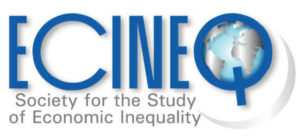A 1-1-1 relationship for World Bank Income Data and the Gini
Working Paper 2018-473
Abstract
The paper provides insights of significant practical relevance into the nature of empirical income distri-bution data, provided by World Bank (and by EU-SILC as well). The insight covers mature states and their economic and societal system. Proceeding from a Gini value .., as published by the World Bank, it is possible to derive, as close approximation, the actual income distribution, with standardised total income 1, and a mathematical representation. We call this the standard Lorenz curve $L_G$. $L_G$ is of type $L_G = 0.6 cdot Pareto(varepsilon) + 0.4cdot Polynomial(varepsilon)$, where $Pareto(varepsilon)$ and $Polynomial(varepsilon)$ are the Pareto and polynomial Lorenz curves for a parameter $varepsilon$ with $varepsilon=frac{1-G}{1+G}$ and $G=frac{1-varepsilon}{1+varepsilon}$. If the total income level of the considered distribution is known, then the distribution of absolute income can also be derived. If, in addition, one knows the number of income earners, then one also knows the distribution of the absolute income within a population. All together our summarizing statement is: "For mature economies, analysing World Bank and EU-SILC income data, there is essentially a cross-country and cross-year 1-1-1 correspondence between the GINI, the corresponding decile resp. quintile information and the respective standard Lorenz curve described above." Some interesting mathematics is involved to reach the main result. The insights obtained will hopefully enable economists and social scientists to further develop their work in the field of income inequality and associated social phenomena.
Authors: Franz Josef Radermacher, Estelle Herlyn.
